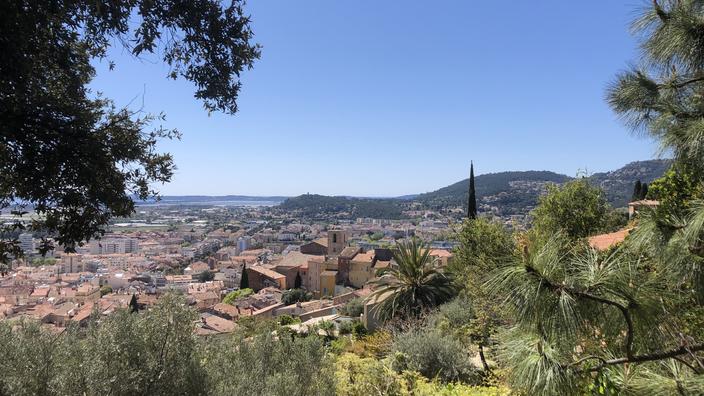Protected by the Giens peninsula and the Golden Islands, the town with three remarkable gardens is worth a detour for its majestic natural setting and its surprisingly diverse heritage.
Only 16 km east of Toulon, Hyères les Palmiers extends over a territory larger than the prefecture of Var, yet three times more populated. An area that allows it to display a diversity of unusual landscapes: sandy beaches meet rocky coves, salt flats are lost in lagoons, agricultural plains alternate with vineyards and wooded hills are measured against the mountains of the massif. Moors, whipped by the mistral.
From the medieval center – perched on a rocky peak – to the modern port facing the Golden Islands, passing through the villages of Salins, Aygade, La Capte or Giens, the urbanized areas offer contrasting faces. Having known many vicissitudes, Hyères has existed since ancient Greece: it was then an important coastal stopover between Massalia (Marseille) and Nikaïa (Nice). The Olbia archaeological site, located not far from Almanarre beach, allows you to discover this history. Subsequently, the city developed rather on the heights and became an important medieval stronghold, protected from Barbary raids by ramparts and a castle, built in the 11th century. Continuing its growth, Hyères fell to the Counts of Provence during the thirteenth century before being attached to the kingdom of France in 1481.
Today, Hyères les Palmiers asserts itself as one of the most popular seaside resorts on the Var coast. This craze is not new, the city attracting tourists since 1830. At the time and for more than a century still, it was frequented by crowned heads, writers and socialites, but only during the winter season. In his 1887 “guide” entitled The Riviera – who popularized this name -, the man of letters and former prefect Stéphen Liégeard made Hyères the oldest health resort on the Côte d’Azur. The streets south of the old center are still lined with hotels with grandiloquent architecture, neoclassical buildings and Moorish villas, very popular at the time.
You enter the medieval town by the Massillon gate before walking up the street of the same name to the stalls full of olives, fruits and herbs from Provence. Around the arts circuit allows the curious to visit the artists and craftsmen who animate the old town. A stop is required at one of the terraces of the place Massillon, dominated by the robust Templar tower. Climbing through the flowery alleys behind, we come across the beautiful Saint-Paul collegiate church, whose construction dates back to the 12the century; don’t miss the old one to see her located just above. Higher still, we discover with delight the Castel Sainte-Claire, the modernist villa Noailles and the old one Hyères castle.
Going back down to the coast, we meet L’Ayguade, a small port bordered by a wide beach where a few huts invite you to relax; further west, the port modern plays a major role in the links with Port-Cros and the Ile du Levant. Bordered by ancient salt flats where migrating birds come to rest, the village of researchers prides itself on its pretty beach with shallow water; more to the south, La Capte also has a taste for holidays with its small houses nestled in the heart of a pine forest, itself fringed by a long beach. For its part, the village of Giens seduces holidaymakers with its very Provençal atmosphere. A coastal path, extended by hiking loops, allows you to go around the entire peninsula around, with rocky coasts. Still remains the little one port of Niel to adore, with its boats taking refuge in a cove. Before joining the Tower plan to embark on Porquerolles?
Read also :From Aix-en-Provence to Saint-Tropez, ten original ideas for (re) discovering Provence-Côte d’Azur
The visit to schedule: Villa Noailles
 –
–Built from 1923 by Robert Mallet-Stevens, the Villa Noailles is a masterpiece of modernist architecture. After having detailed the geometry of the exteriors, we visit the permanent exhibition which reveals the functionality of the interior. Photos, documents and original furniture – signed Marcel Breuer or Eileen Gray – reveal the intimacy of the owners, Charles and Marie-Laure de Noailles, enlightened patrons of the Roaring Twenties. But Villa Noailles is also a famous art center which organizes several festivals and exhibitions each year. At the end of June, place at the Design Parade Hyères, a competition for young designers whose jury will be chaired this year by Constance Guisset. Several exhibitions will be presented on the sidelines of the competition: one of them will be devoted to Hélène Henry, a virtuoso weaver close to Charlotte Perriand.
Villa Noailles, Montée de Noailles, 83400 Hyères. Phone. : 04 98 08 01 98. Design Parade Hyères: competition from June 25 to 27; exhibitions until September 5, 2021.
Read also :In Hyères, with the Noailles
Nature walk: commented excursion in the Salins des Pesquiers
 –
–A large part of the Hyères coast is occupied by salt marshes. Known since antiquity, they were redeveloped in the 19th century for the industrial production of salt before being definitively abandoned in 1995. Since then protected by the Conservatoire du Littoral, they are teeming with wildlife. The visit of Saltworks of Pesquiers, located on the isthmus leading to the Giens peninsula, is only done in the company of a naturalist guide from the LPO. Nearly 300 species of birds, migratory or not, meet here between ponds and lagoon: Shelduck ducks, white stilts or pink flamingos are rather easy to observe. To the Old Salins, which extend to the gates of La Londe-les-Maures, the exhibition of nature space will pleasantly extend the visit, as will the interpretive trail that winds between dikes and canals.
Salins Des Pesquiers: route de Giens, La Capte. Guided tours only, bookable at the Hyères tourist office (Tel .: 04 94 01 84 50) or by line. Count 5 € for 2 hours of visit. Nature area of the Vieux Salins d’Hyères : at Les Salins, next to the Pothuau port. Phone. : 04 94 01 09 77.
The terrace where to sit: Queen Jane
 –
–If this hotel looks fifties He is often talked about for his rooms designed by young designers, it would be a shame to miss his table … First of all because it has a wonderful terrace, which unfolds in the shade of a venerable mulberry tree -plane tree. But also for its summer cuisine, always full of colors, which gives pride of place to local fish and seafood: Tamarisk oysters, sea bass ceviche with coriander and Espelette pepper, grilled octopus with Chimichurri sauce or turbot white accompanied by candied fennel, difficult to choose. On summer evenings, we climb on the rooftop to test the tasty cocktails – or mocktails – of the house, while enjoying an unforgettable view of the Golden Islands and the port of Aygade. Count from 35 to 50 € for a complete meal.
Queen jane, 1 quai des Cormorans, L’Aygade, 83400 Hyères. Phone. : 04 94 66 32 64. Reservations recommended, including for the rooftop.
The event to be included in the agenda: “Rendez-Vous aux Jardins”
 –
–The nickname of Hyères “the Palm trees”? The city owes it to the 7000 palm trees that line its streets but also to its countless nurseries. Because from the beginning of the 19th century, its exceptional climate allowed it to acclimatize all kinds of exotic plants. At the beginning of June, the Meet at the Gardens are the perfect opportunity to discover the Remarkable Gardens of Hyères. Olbius Riquier, both a botanical and leisure garden, will host strolls and shows for children. The Sainte-Claire Park, built around a castle overlooking the old town, can be visited in the company of a guide or a photographer, who will enjoy detailing the species from South America or Australia. As to Saint-Bernard Park, the abundant garden laid out “in terraces” under the Villa Noailles, we will follow an “exquisite stroll” directed by a choreographer.
Meet at the Gardens : June 4-5-6, 2021. Olbius Riquier Garden: 37 BC Ambrose Thomas. Phone: 04 94 00 78 65. Sainte-Claire Park: Allée Castel Sainte-Claire. Saint-Bernard Park: climb of Noailles.
The panorama to contemplate: from the castle of Hyères
 –
–In this city built on rocky peaks dominating the entire region, the spectacular panoramas are endless. There is the one visible from the Fairy Peak, where there is an astronomical observatory; or the point of view that we discover around Our Lady of Consolation, at Costebelle… But if there is one panorama not to be missed, it is obviously the one that we contemplate from the ruins of Hyères castle, built by the Lords of Fos in the 11th century and fortified by the counts of Provence. By climbing to the heights that welcome it, one easily understands the strategic interest of this site offering breathtaking views over the roofs of the old town, the hinterland, the port, the salt marshes, the peninsula of Giens and the Golden Islands. An ideal perch for patiently reconstructing the complex geography of Hyères and its “villages”.
Advice : the least difficult is to climb by the rise of Noailles but it can also be reached by the alleys and stairs located above the Saint-Paul collegiate church. Free access.
The address where to put your suitcases: Le Lodge des Îles d’Or
 –
–In the shade of a pine forest dotted with holm oaks and in the heart of a lush garden, this is the ideal address to recharge your batteries while enjoying the Hyères coast. With its wood-clad buildings integrated into nature, the whole evokes the best boutique hotels in Asia, plus the cicadas. The 22 spacious and comfortable rooms all have large terraces overlooking the heated swimming pool. What about the beach? It is only a few steps away if you follow the small path that begins at the bottom of the garden. Another strong point of the establishment is its program of sports or well-being activities: paddle boarding, guided hikes, yoga sessions or massages, the choice is yours … As for the restaurant “La Table du Lodge”, it offers tasty Mediterranean cuisine with Asian touches. Rooms from 150 € per night. A la carte lunch around € 30, dinner around € 45. Activities from 15 to 70 €.
The Golden Islands Lodge : 4205 Route de Giens, 83400 Hyères. Phone: 04 94 41 38 38.
Read also :Porquerolles, our essentials in the pearl of the “Golden Islands”
More information on the destination Hyères: hyeres-tourisme.com
– .


